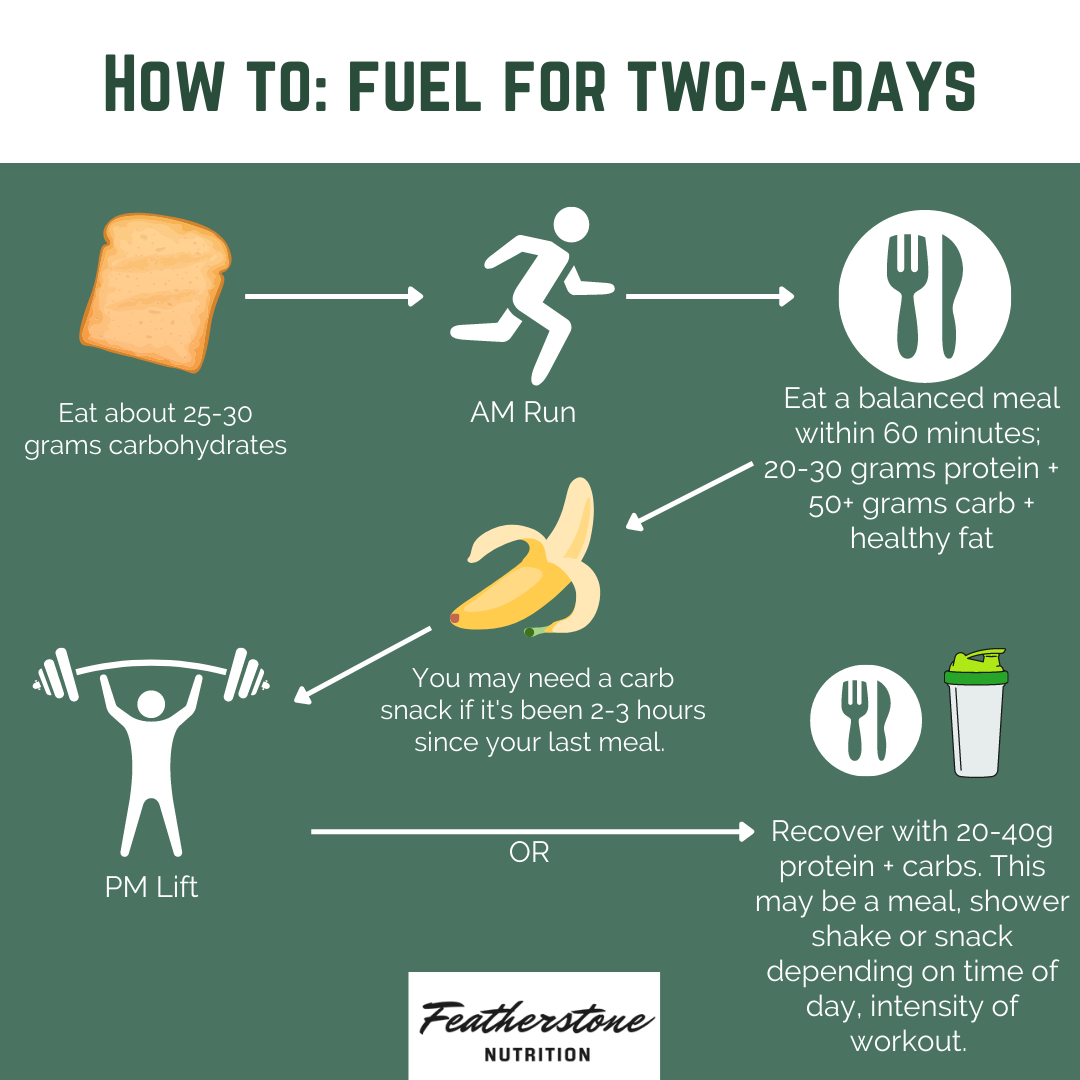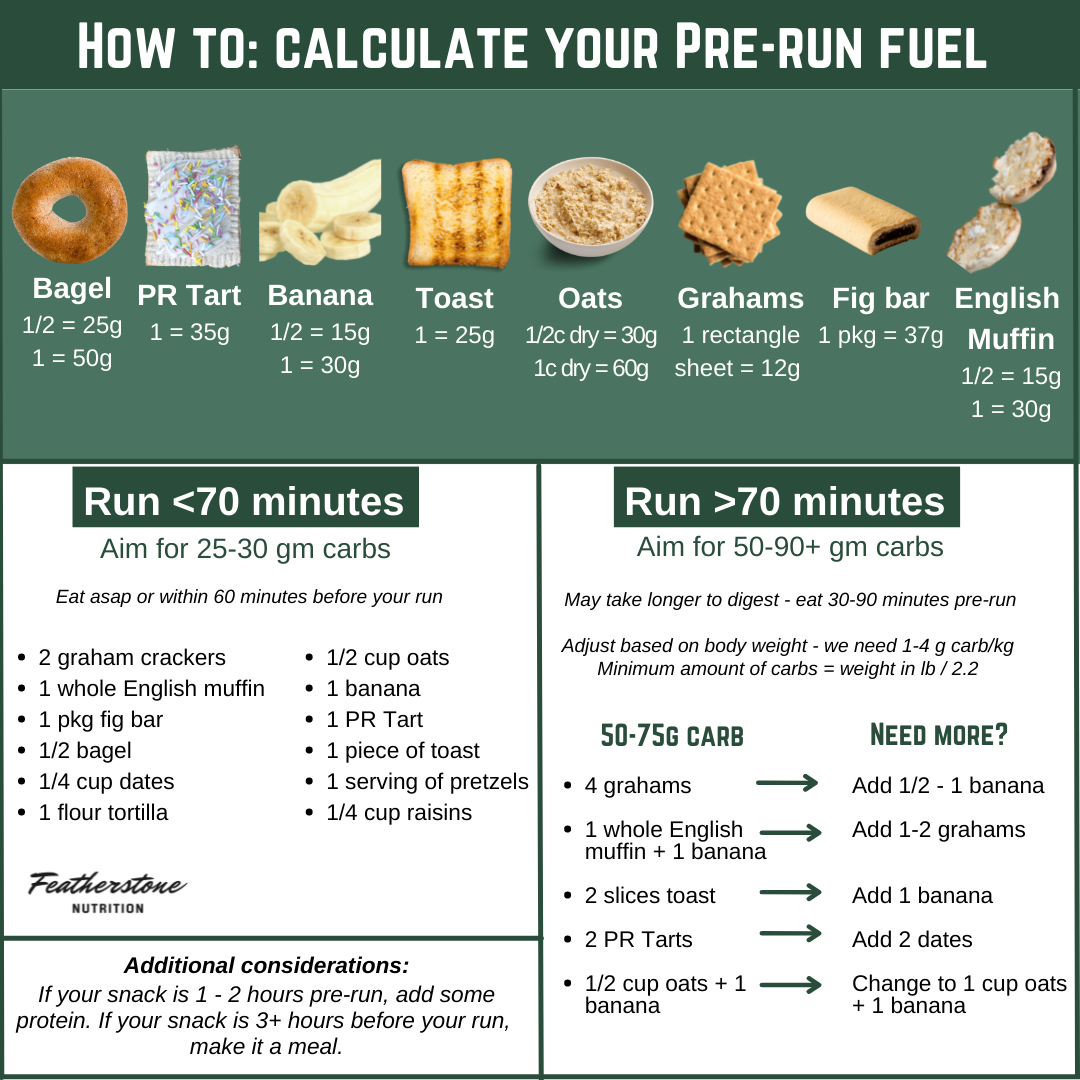Fueling for strength training & two-a-days
Fueling for Runners Part II: Fueling for Strength Training & Two-a-Days
Last week, we explored why and how you should fuel for long and short runs and speed sessions. Now let’s move on to other types of training that a lot of athletes ask me about: strength training sessions and two-a-days. Keep reading to find out why your fueling needs for these workouts are different, what happens if you’re not eating adequately for your workouts and how you can power up your performance by making just a few simple fueling tweaks.
When considering your fueling needs for running, you should take into account both exercise duration and intensity. It’s an even bigger consideration when you throw strength training into the mix as a standalone session or part of a two-a-day. Whether you’re leaping through plyometric exercises or lifting barbells, kettlebells, and other weights, gym workouts tend to be high intensity. And as you could be using many different muscle groups, you’re going to consume an awful lot of energy in even your shortest strength or power workouts. Going for a run the same day? Now you need even more fuel.
The trouble I find with many new clients whose gym sessions and two-a-days aren’t working for them isn’t the programming itself; it’s that they only focus on fueling for runs OR workouts and usually aren’t sure how to fuel for BOTH. Not fueling your body properly for your workouts can lead to short changing your sessions and overall gains.
Why you need carbs before strength workouts
Much like with running, gym training requires quick-acting fuel that’s available on demand. This is a prerequisite for rapid muscle contractions – concentric as you shorten the muscle fibers and eccentric while you lengthen them under tension. These kinds of exercises not only require you to move quickly but also powerfully (think the combination of strength and velocity), which recruits a greater number of muscle fibers and takes even more energy.
A review released via Sports Medicine stated that carbs make “a greater relative contribution to energy production where exercise is of moderate-to-high intensity,” with standard volume strength training depleting glycogen stores by 24 to 40 percent. The authors explained that this can be much higher, referencing a prior study that observed glycogen running out in certain muscle fibers. With this in mind, they concluded that ingesting pre-workout carbs improves performance in high-volume strength workouts lasting 45 minutes or longer and/or when you haven’t eaten for eight hours (such as when you hit the gym first thing in the morning).
These physiological demands show why it’s essential that you’ve got enough fast fuel available to go into overdrive set after set and rep after rep, like a car getting a nitrous oxide boost in The Fast and the Furious. This means blood glucose first and stored glycogen second, both of which are provided by – you guessed it, carbohydrates. Just like on your runs, fat could potentially be utilized for fuel in your strength training but because it takes so long to access and utilize, it’s unsuited to the task. Instead, plan to top up your gas tank with carbs before you hit the weights, which you could get from a piece of toast, half a bagel or muffin, or a small bowl of cereal. Afterwards, don’t forget your post-workout recovery nutrition of protein + carbs (we will discuss recovery nutrition in future articles).
How do I fuel for a two-a-days?
Some athletes find it challenging enough to dial in their fueling for a single daily workout, so what happens when we throw two-a-days into the mix? If you are not fueling adequately, the answer is often that you end up in a calorie deficit, don’t intake sufficient protein to start the repair process, and consume too few carbs to replenish your glycogen stores for the second session. As a result, you might be sluggish and slow during training and fatigued and sore afterward.
To avoid this, aim to take in at least 25 to 30 grams of carbs before lifting or running (whatever comes first), and make it more if you’re planning to go longer or harder. If you have hours in between your workouts, you should refuel in between with a combination of carbs and protein with three purposes in mind – replenishing nutrients you just used, beginning the repair process, and fueling up for what’s to come.
Another review of studies that investigated the link between carb intake and resistance training noted that if “there is another high-intensity workout planned that day for the same musculature, higher carbohydrate intakes up to 1.2 g/kg/h may be warranted to maximize glycogen resynthesis in between workouts.” An International Society of Sports Nutrition position paper suggested “combining carbohydrates (0.8 g/kg/h) with protein (0.2-0.4 g/kg/h)” when there’s less than four hours between workouts. While whole grains and low-glycemic foods are often nutrient rich, they recommended easily digestible ones that are high on the glycemic index when trying to refuel between two-a-day workouts.
These numbers might seem like they only complicate matters but refueling post-run and pre-lift or vice versa doesn’t need to be tricky. Eat a meal or large snack that includes carbs + protein, such as cottage cheese with fruit, or a buffalo chicken salad sandwich. If you need something quick & easy, try a Shower Shake that also includes protein powder, oats and fruit. Quantities of carbs and protein is depending on your body size, age & workouts, as well as if your recovery nutrition is a snack or a meal.
In addition to providing more fuel for the physical side of your second workout, fueling in between your two-a-days will help you achieve better cognitive performance. If your blood sugar is too low after the first session, you’ll probably struggle to focus and pay attention during the second one. Whereas if you eat carbs, you’ll be more alert and focused, maintain proper form, and concentrate on cues that can ensure you have a high-quality session.

How do I fuel for a strength training immediately before running?
If you lift and run back-to-back, take a guess at what our fuel source before each segment is…CARBS! Aim to take 25-30 grams of carbs before your lift and then another 25-30 grams of carb before your run (or more if you are running >70 minutes). See our last blog post for tips and examples.
In summary, you should always fuel with carbs before every run and strength training workout. Eating solid meals between two-a-days is also a must. Don’t worry if you have to add an extra snack or meal during the day and/or another one at night – your body needs that additional energy to perform and recover well. Stay tuned to future articles focusing on recovery post-runs and workouts.
Check back soon for the final installment of this series, in which we’ll break down fueling for race day.
1. Andrew King, “The Ergogenic Effects of Acute Carbohydrate Feeding on Resistance Exercise Performance: A Systematic Review and Meta-Analysis,” Sports Medicine, July 9, 2022, available online at https://link.springer.com/article/10.1007/s40279-022-01716-w. 2. Harry P. Cintineo et al, “Effects of Protein Supplementation on Performance and Recovery in Resistance and Endurance Training,” Frontiers in Nutrition, September 11, 2018, available online at https://www.ncbi.nlm.nih.gov/pmc/articles/PMC6142015/#B28. 3. Daniel W.D. West et al, “Whey Protein Supplementation Enhances Whole Body Protein Metabolism and Performance Recovery after Resistance Exercise: A Double-Blind Crossover Study,” Nutrients, July 11, 2017, available online at https://www.ncbi.nlm.nih.gov/pmc/articles/PMC5537849. 4. Menno Henselmans et al, “The Effect of Carbohydrate Intake on Strength and Resistance Training Performance: A Systematic Review,” Nutrients, February 18, 2022, available online at https://www.mdpi.com/2072-6643/14/4/856. 5. Chad M. Kerksick et al, “International Society of Sports Nutrition Position Stand: Nutrient Timing,” Journal of the International Society of Sports Nutrition, August 29, 2017, available online at https://pubmed.ncbi.nlm.nih.gov/28919842.
Disclaimer: The content in our blog articles provides generalized nutrition guidance. The information above may not apply to everyone. For personalized recommendations, please reach out to your sports dietitian. Individuals who may chose to implement nutrition changes agree that Featherstone Nutrition is not responsible for any injury, damage or loss related to those changes or participation.
Which runs do I need to fuel for?
Fueling for runners part I: Which runs do I need to fuel for?
There are several essentials you’d never forget before going out to run: your shoes, your watch, and maybe your water bottle, too. These external things are important, yet all too often, we forget that for our training to be successful, we also need to focus on powering up from the inside out. In this first installment of a three-part series, let’s look at why you should fuel for every run, how to do so for different sessions, and what it can mean for your performance.
What happens if I don't fuel my run?
Runners often fall somewhere between those who are serious about pre-run fueling and those who don’t fuel at all. The former is great when it’s done right, while the latter can leave runners feeling depleted. Some common reasons runners skip pre-run fueling are:
- you don’t think you need it
- you are worried about GI distress
- you are busy and forget
- you don’t prioritize it
- your runner friends don’t fuel pre-run
- you think if you’re fasted, you’ll burn more fat
All of the factors discussed above contribute to many athletes shortchanging their potential progress and gains by not fueling. As we explored in a recent post, you need an ample supply of carbs to utilize as fast-burning fuel, first via glucose in your bloodstream and then from glycogen stored in your muscles and liver. The authors of a study published in the Journal of Sports Sciences wrote that “Carbohydrate availability is increased by consuming carbohydrate in the hours or days prior to the session, intake during exercise, and refueling during recovery between sessions.”
If you don’t check all three of these boxes, then you’re going to find it difficult to achieve your target pace and stick with it, might start to fatigue sooner, and will feel like you’re working harder than you should be. A position statement from the Academy of Nutrition and Dietetics, Dietitians of Canada, and the American College of Sports Medicine stated that short-term low energy availability leads to decreased muscle strength, reduced endurance capacity, and a blunted response to training. On the mental side, inadequate fueling can also cause lack of focus, mood irregularities, and a loss of coordination that could increase your risk of injury. You probably wouldn’t plan to head out on a road trip if your gas tank was low or even empty, so why would you risk it with your own body?
Do I need to fuel before my short runs?
The thinking on short runs has typically been that your body has sufficient glucose and glycogen to power you through. But this is based on the premise that you’ve been eating optimally throughout the day and are coming into your training fresh and adequately fueled. The trouble is that you might not be, so if you’re starting from a calorie, carb, or energy deficit, things aren’t likely to go well. When you don’t have enough quick-acting glucose to power your shorter runs (or any activity, for that matter), you’ll need to tap into stored glycogen first and fat second, neither of which are as efficient. Think about the difference between putting small pieces of kindling on a fire versus loading a big log on top – one burns quickly while the other takes time to burst into flames and then break down.
Another potential issue with going into a shorter run in a fasted state is that it increases your stress response. As a result, your body pumps out cortisol and other stress hormones, putting you in a high-alert, fight-or-flight state. That’s not ideal during what’s supposed to be an easy run, and it will result in you feeling like you’re working harder than usual. Afterward, you might be drained because the overall load of the session is higher due to the increased stress on your body.
In contrast, if you eat something before a short run, you’ll have sufficient fuel to provide ready energy, hit your performance target with lower perceived exertion, and keep your stress response under control. Another benefit is that you won’t have dug yourself deeper into a deficit, so it will be easier to fully recover.
So what should you eat before a short run (70 minutes or less)? The simplest answer is a small amount of simple carbs. For fruit, this could be quarter of a cup of raisins or dates or a banana. Good grain-based options include half a bagel, a piece of toast, an English muffin, or a flour tortilla. Seeking a convenient snack? Then consider a PR Tart, serving of pretzels, or two graham crackers. If you’re looking at nutrition labels, 25 to 30 grams of carbs is the sweet spot, but don’t overthink this. Try eating something from the graphic below in the hour before you start your run, along with 8-16 ounces of fluid so you’re hydrated.
If you’re pushed for time, don’t use this as an excuse to skip fueling. Remember that fast-acting carbs will start to digest in as few as 15 minutes. I get a lot of questions about including fat and protein with pre-training snacks. There’s nothing wrong with this, but as they digest more slowly than simple carbs alone (same goes with fiber), add a bit more time if you’re going to spread butter on your toast, cream cheese on your bagel, or nut butter on your banana. Incorporating protein is a great strategy if you’re snacking one to two hours before a run. If there are three or more hours until you train, you should make your snack a full meal.
What do I need to do differently for long runs?
Longer runs (70 minutes or more) present a different fueling challenge to shorter ones because you’re more likely to burn through the glucose in your bloodstream and at least some of your glycogen stores. So there’s an even greater need to fuel up before you head out. A simple rule of thumb is to double the carb portion that you’re eating before short runs (this can also apply to higher intensity shorter sessions, as these place a greater demand on your body and require it to consume more fuel at a quicker rate.) If you’d snack on two graham crackers for a 45-minute steady state session, try eating four prior to a 90-minute one. You can also start combining carb sources, such as a banana with half a cup of oats, two dates and two PR Tarts, or a fig bar and two pieces of toast (check out more suggestions here).
These quantities should put you into the lower end of the 50-to-90-gram range I typically recommend to clients for longer sessions. You can go a little further by using the equation in the graphic above to determine your carb range, and then consider working with a sports dietitian if you want to really dial in your personalized fueling needs. As you’ll be increasing the amount you’re eating, digestion might take longer so try to eat 30 to 90 minutes before your longer run.
While you shouldn’t need to refuel during shorter runs, you don’t want to completely burn through your carb stores during longer ones and have to rely solely on fat because it’s a slow energy source and not the preferred fuel source. With this in mind, start intra-run fueling within the first 30 to 45 minutes of longer sessions. The range for carb replenishment is anywhere from 40 to 80 grams an hour depending on body size, intensity, training status, and so on, so you’ll need to experiment a little. A good place to start is 1 serving (25-30g carb) every 30 minutes.
Fuel uptake and hydration are interrelated, so I recommend drinking the same 8-16 ounces of fluid as you would before a short run and carrying additional fluids with you for any session lasting an hour or more. If you’re using a hydrogel, you might need less fluid, but if not, try combining your regular gel (or tab, chew, etc.) with water. When it’s hot and/or humid, consider a sports drink that contains electrolytes so you can replace some of the sodium you are losing through sweat.
How should I fuel speed sessions?
A lot of the runners I work with focus on fueling their distance sessions, but speed training also requires smart fueling, whether that’s hill sprints or track intervals. The authors of the ACSM position paper mentioned earlier states that carbohydrate availability enhances long workouts with high intensity intervals while depleted levels of carbs are associated with reduced work rates, impaired skill and concentration, and increased perception of effort.
To avoid such side effects and maximize the benefits of your longer speed workouts (70 to 90 minutes), make sure you’re fueling appropriately. This looks a little different to regularly paced runs of a similar duration. It takes more time for fuel and fluid to empty out of the stomach during high-intensity sessions, with one researcher finding that gastric emptying was around 50 percent slower when VO2 max was at 90 percent. This means you’re at greater risk of nausea, cramping, and other kinds of stomach discomfort if you’re sucking down a mid-workout gel. So eat a carb-rich snack beforehand, only use gels during your warmup so they empty from your stomach before the intensity gets too high, and sip a sports drink in between intervals/reps.
To recap, you need fuel for every kind of run, so no matter if you’re going fast, short, or long, ensure you’re doing some kind of pre-fueling based on simple carbs. Don’t skip or skimp and try experimenting with the guidelines above to find what works for you. Then commit to sticking with it. During longer runs, keep your energy and electrolyte levels up with a combination of gels, water, and sports drinks. Check back soon for part 2 in this series, when we’ll explore fueling for strength training and two-a-days.
Still need help with your fueling and hydration strategy? I’d love to put together a customized plan for you.
1. Louise M Burke et al, “Carbohydrates for Training and Competition,” Journal of Sports Sciences, 2011, available online at https://pubmed.ncbi.nlm.nih.gov/21660838. 2. D Travis Thomas et al, “Nutrition and Athletic Performance,” Medicine & Science in Sports & Exercise, March 2016, available online at https://www.researchgate.net/publication/297695609_Nutrition_and_Athletic_Performance. 3. Carl Foster, “Gastric Emptying During Exercise: Influence of Carbohydrate Concentration, Carbohydrate Source, and Exercise Intensity,” Fluid Replacement and Heat Stress, (Washington, D.C., National Academies Press, 1994), available online at https://www.ncbi.nlm.nih.gov/books/NBK231135/?report=classic.
Disclaimer: The content in our blog articles provides generalized nutrition guidance. The information above may not apply to everyone. For personalized recommendations, please reach out to your sports dietitian. Individuals who may chose to implement nutrition changes agree that Featherstone Nutrition is not responsible for any injury, damage or loss related to those changes or participation.
Why you need to stop being scared of carbs
There are a lot of misconceptions about nutrition, but it’s arguable that carbohydrates are the most misunderstood and unfairly maligned macronutrient. Whether it’s lingering notions from low-carb fads like the Atkins diet, more recent exclusionary eating approaches, or misinformation from social media, many of the athletes who come to me are underperforming because they’re simply not consuming enough carbs or avoiding them completely. We’re here to set the record straight on what carbs do in your body, how they fuel your training and recovery, and why you might need more of them than you’re currently getting.
Carbs as fuel
Of the three macronutrients, carbs provide the most readily available fast fuel source, as your body breaks them down into (most abundantly) glucose, that’s quickly sent into your bloodstream and shuttled to your muscles, brain, organs, and so on. Any extra glucose that isn’t utilized right away is stored as glycogen in your muscles and liver, so it can be put to use later.
For as much hype as there is around becoming “fat-adapted” and developing greater “metabolic flexibility,” carbs are still the fuel source that’s preferred by your entire body, especially for endurance athletes. One of the reasons is that while stored fat offers a much larger potential energy reserve than carbs, it takes much longer to tap into this energy when you need fuel immediately during training or racing. While fat can be a valuable energy source for low-to-moderate intensity activities that have a lower energy demand, research has shown that when our bodies are working at the higher end of our VO2 Max, carbohydrates are the fuel source we need to have readily available.
More miles = more carbs
...but we still need carbs without the miles
The more miles you put in, and the faster you cover them, the more carbs you need. It’s the optimal fuel for high-intensity performance, providing sufficient energy to power muscle contraction and help you achieve and sustain your target pace. This first comes from glucose in your bloodstream that is available as soon as 15 minutes after you eat simple carbs, and then, from stored glycogen. Low carb intake = low glycogen stores = poor performance.
Just because more miles and greater intensity should equal more carbs consumed, it doesn’t mean no miles = no carbs. There’s a common misconception among athletes that on days when their program only calls for an easy run or a real rest, they should dramatically cut down on their carb intake or eliminate it altogether. This neglects the fact that even at rest, your body typically gets about 20 percent of its fuel from glycogen, while your brain requires at least 130 grams of carbs per day to function optimally according to the National Academies’ Institute of Medicine, no matter what your training load is. Plus, you need to replenish the glycogen stores that you depleted on a heavy or moderate training day. In other words, stop cutting out carbs when you have a low mileage, low intensity, or off day planned.
Carbs & hydration
Carbohydrates also help our bodies to absorb water and certain electrolytes during training and racing so that you don’t become dehydrated. Research shows that when we consume water + sodium + glucose together, absorption and hydration increases. A study found that a drink containing carbs and electrolytes helped participants finish a 21-kilometer time trial faster and with better visual motor capacity than those who used a placebo.
Carbs for recovery
After training, most of the refueling advice has focused on getting enough protein into your body as quickly as possible to aid muscle repair. This is true, but, if you don’t have enough carbs in your system, this will be less effective, and muscle breakdown can still occur because your body will start using amino acids for energy instead of restoring and building muscle. Combining carbs with protein right after training in a meal, smoothie or shake will not only spare amino acids for repair, but also help you bounce back strong by replenishing the glycogen stores that you depleted during your workout.
How to know if you're eating enough carbs
We just explored some ways that carbs power performance and recovery. But how do you know when you’re not consuming enough? During your training, you might struggle to hit paces or find that you’re running out of steam earlier than usual. A paper published in Applied Physiology, Nutrition, and Metabolism found that during an intense cycling session, time-to-exhaustion was reduced for participants who were low on carbs and concluded that a low-carb diet “reduces both performance and total aerobic energy provision during supramaximal exercise.” Cutting back on carbs can also hamper your decision-making during and after exercise.
Some of the side effects of not eating enough carbs – particularly when paired with an overall calorie deficit – can mimic the perils of overtraining, such as increased perceived exertion, excessive and persistent muscle soreness, and hormonal/menstrual cycle disruption. You could also feel like you’re low on energy, fatigued, and more emotionally volatile than usual. If you have trouble falling or staying asleep or wake up feeling like you need another couple of hours in bed, low-carb intake could be partly responsible, with researchers suggesting that this reduces the amount of time spent in REM sleep.
Eating more carbs (the right way)
Fortunately, if you find that you are underfueling, fixing it is easy: eat more carbs! You can do this by choosing foods that contain 70 to 95 percent carbs, including pasta, bread, rice, bananas, and bagels, instead of high fat foods such as french fries, donuts or chips. (Eating these occasionally is totally fine! But, doing it all the time would increase your caloric intake, as well as possibly increasing GI distress due to the higher fat content.) You can use high carb foods as standalone snacks on either side of your workouts, and also incorporate them into breakfast, lunch, and dinner. Then during your training, consider using goos, gels, tabs, sports drinks, and other sources of simple carbs to keep you going.
We’ll go into much more detail on fueling strategies for short and long runs and rides, strength sessions, two-a-days, and races in an upcoming three-part series. But the short version is that increasing your carb intake can take the brakes off your performance, improve your recovery, and stabilize your sleep and mood. And as you will be nailing more workouts than ever before, you’ll find it easier to achieve your fitness goals. So, there’s really no reason to be scared of carbs – except if you’re not eating enough.
1. “Report Offers New Eating and Physical Activity Targets To Reduce Chronic Disease Risk,” National Academies of Sciences, Engineering, and Medicine, September 5, 2002, available online at https://www.nationalacademies.org/news/2002/09/report-offers-new-eating-and-physical-activity-targets-to-reduce-chronic-disease-risk.2. EM Wright and DD Loo, “Coupling Between Na+, Sugar, and Water Transport Across the Intestine,” Annals of the New York Academies of Sciences, 2000, available online at https://pubmed.ncbi.nlm.nih.gov/11193601.3. Z Gui et al, “Effect of Protein and Carbohydrate Solutions on Running Performance and Cognitive Function in Female Recreational Runners,” PLOS ONE, October 12, 2017, available online at https://journals.plos.org/plosone/article?id=10.1371/journal.pone.0185982#. 4. Adriano E Lima-Silva et al, “Effects of a Low- or a High-Carbohydrate Diet on Performance, Energy System Contribution, and Metabolic Responses During Supramaximal Exercise,” Applied Physiology, Nutrition, and Metabolism, September 2013, available online at https://pubmed.ncbi.nlm.nih.gov/23905657.5. Ahmad Afaghi et al, “Acute Effects of the Very Low Carbohydrate Diet on Sleep Indices,” Nutritional Neuroscience, August 2008, available online at https://pubmed.ncbi.nlm.nih.gov/23419282.
Disclaimer: The content in our blog articles provides generalized nutrition guidance. The information above may not apply to everyone. For personalized recommendations, please reach out to your sports dietitian. Individuals who may chose to implement nutrition changes agree that Featherstone Nutrition is not responsible for any injury, damage or loss related to those changes or participation.









